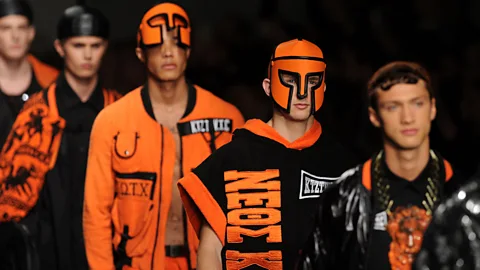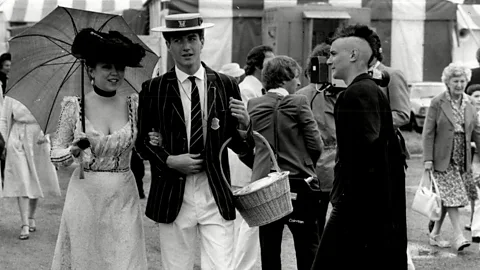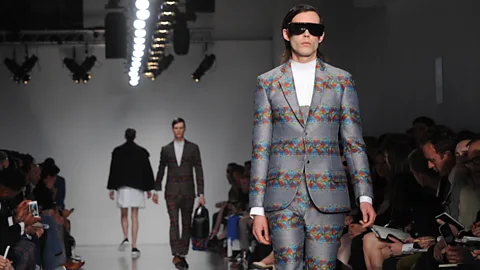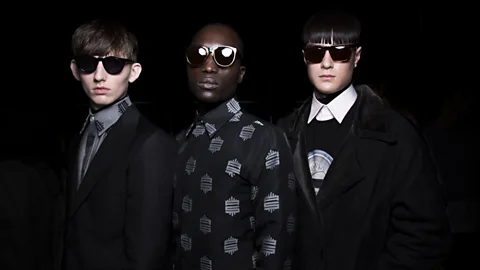The rebel spirit of British style

British menswear is known for pushing boundaries. How does this radical tradition affect fashion today? Lindsay Baker takes a look.
Flamboyant radicals and unkempt rebels have long been part of Britain’s sartorial history, from louche, pantaloon-clad dandies to anarchic punks in bondage tros. In fact youthful disruption and rebellion are as much part of the country’s menswear heritage as their polar opposite – the buttoned-up, formal dressing of Britain’s class-conscious heritage. But why is that?
Menswear the world over is in its ascendancy, it seems, and this is particularly true in the UK. Sales have grown by 18% from 2008 to reach £12.9bn in 2013, according to Mintel; and it forecasts that the men’s fashion market will grow by 27 % between 2013 and 2018. If the success of London Collections: Men (LC:M, the UK capital’s menswear fashion week)is anything to go by, the maverick spirit is alive and well. The collections of the emerging designers on show in the event, now in its fifth season, are frequently daring and challenging.
The rebellious tradition goes back to early style icons, such as the Romantic poet Lord Byron, famously described as ‘mad, bad and dangerous to know’. Although an aristocrat, Byron was nevertheless associated with revolt and radicalism, with a brooding temperament and penchant for claret-red velvet to match. Beau Brummell was also among the first to favour a subversively dandyish look.

By the 1950s bohemian London was in full swing. Alongside peacock Bunny Rogers and his neo-Edwardianism were the Teddy Boys, who created a new style of dandy. Other vibrant musical subcultures followed in quick succession, from the sharp-suited mods and ska-loving rude boys to hippies to punks, goths, New Romantics and grunge kids.
“Creativity can spring from rebellion,” says British milliner Stephen Jones, who has collaborated on collections with the likes of Vivienne Westwood and John Galliano, and created hats for clients as diverse as Diana Princess of Wales and Marilyn Manson. “In rejecting one thing you are forced to fill the vacuum with another creative idea. For example when I was young, the New Romantics filled the vacuum that was left by punk.”
And according to Jones, LC:M “straddles an interesting point between orthodox Savile Row tailoring and … younger menswear which is either coming from surf, street, skater culture including music or from art school. I think [young designers] maybe do not need the spirit of rebellion, but they have not lost the spirit of creativity at all.”

A different class
Just as subcultural movements react against the style and attitude of the ones that came before, it could be argued that Britain’s rigid, class-dominated heritage – with its strict dress codes and stiff-upper-lip attitude – has inadvertently provided the perfect breeding ground for its subversive, creative style tribes.
Dylan Jones, chairman of LC:M and editor of UK GQ magazine, thinks Britain "does subversion" better than anyone else. “I think we’re very good at tradition and we’re very good at rebellion,” he tells BBC Culture. “All of the best youth tribes and pop groups came out of the UK – it’s in our nature. I think we’re more iconoclastic, more idiosyncratic, we’re perhaps more prepared to speak our minds even though we come from an incredibly traditional, class-based society.”

Certainly LC:M is proving a success. “London has momentum,” says Jones. “It has Savile Row, the best street style in the world and now we have the big talismanic international brands – Burberry, Tom Ford, Alexander McQueen – using the city as their base.” And interestingly, the three-day event focusses as much on tradition and British history as it does on innovation – and both complement each other. “Heritage is something we take for granted here,” says Jones (who was once an extravagant New Romantic and is now a navy-suited Establishment figure, particularly since receiving an OBE last year). So, Prince Charles hosted the launch of LC:M at Clarence House, and there have been events and shows in Spencer House, Lord’s cricket ground, Downing Street, the War Rooms and St Pauls Cathedral. One recent presentation took place in a cutting room in Savile Row, a historic district that – thanks largely to LC:M - is now booming again, attracting clients from all over the world.
‘Brave new world’
And according to Jones, youthful creativity is stronger than ever too: “It’s more diverse now – in east London you’ll see dozens and dozens of sub-sects and street tribes – more men are interested in fashion than ever before. Now young guys have no qualms about fashion, they expect the same amount of retail opportunities as women do. We’ve got two generations of men who’ve grown up with images of themselves directed back at them – and now everybody’s in the media, which is fantastic. It’s a brave new world out there.”
But has –‘rebel fashion’ simply become the mainstream? Is there anything left to protest about or rebel against? Yes, says Sam Cotton of east-London-based design duo Agi & Sam – winners of Emerging Menswear Designer at last year’s British Fashion Awards. “We raise some political points at times,” he tells BBC Culture. “With our last season we created faux oil companies to try and show how conglomerate companies are bastardising countries’ natural resources.” Cotton adds that the duo are strongly influenced by subcultures.

Similarly, fellow British designer Adrien Sauvage, creator of A Sauvage, is inspired not by a single influence but by the “weird journey” that has brought him to where he is. “I’ve been a part of lots of different tribes,” he tells BBC Culture. “My parents are from Ghana – I consider myself a kind of ‘Afropolitan’. I was brought up in south London with a rude boy, hip-hop look.” He also played basketball for England for seven years – and now dresses several NBA players, including Dwyane Wade of the Miami Heat NBA All Stars.

For him, Britain is not the dominant force now in street-style– it’s the US. “The rude boy look now is more tailored with a slimmer fit, mixed with a skater-boy look – and a lot of American brands like Stussy and Supreme. Hip hop is the new punk. Kanye West getting married to Kim Kardashian in Givenchy – and dominating the news agenda. That’s punk.” Certainly there’s no mistaking the punk references in Pharrell Williams’ outsized Vivienne Westwood hat, originally worn in the video for Malcolm McClaren’s classic rap-punk hit Buffalo Gals.
Despite all this, there’s the undeniable rise of ‘normcore’, the trend for bland, nondescript dressing recently identified by New York magazine. “I actually think it’s kind of rebellious to say: ‘I’m not into anything,’” says Sauvage. “But probably it’s more to do with being scared of experimenting, and sometimes that’s not such a bad thing.” He laughs. “Sometimes people experiment too much.” Ultimately, though, normcore is not for him. “It’s too easy. I’m not into anything too easy. It’s pretty lazy to not make an effort at all.”
Or as flamboyant milliner Stephen Jones puts it: “I think [normcore] is ok because after having a rich meal, sometimes you want a simple salad or a glass of water, but basically a rich meal is more interesting.”
If you would like to comment on this story or anything else you have seen on BBC Culture, head over to our Facebook page or message us on Twitter.
